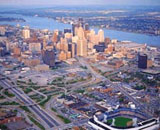|
  
- UID
- 12794
- 帖子
- 8745
- 积分
- 11208
- 学分
- 55197 个
- 金币
- 800 个
- 在线时间
- 795 小时

|
|
Detroit (U.S.) |  Since its 1950s heyday(全盛期)when Detroit was home to more than 2 million residents, the city has suffered some hard times. The city has been considered a national symbol of urban decay, the center of the so-called Rust Belt; its population has slipped to around a million. Since its 1950s heyday(全盛期)when Detroit was home to more than 2 million residents, the city has suffered some hard times. The city has been considered a national symbol of urban decay, the center of the so-called Rust Belt; its population has slipped to around a million.
But thanks to the car industry boom of the mid-1990s, Detroit is now staging a steady comeback(恢复). It's not a Chicago or even a Cleveland, but the Motor City is culturally rich. Detroit's population is 80% black, making it a national center for African American culture. One of the most famous attractions is the city's Motown Museum(摩城博物馆)where Stevie Wonder first played, and it's worth your while to spend an evening at one of the many music clubs scattered throughout the city.
Detroit is situated in the flat plains of southeast Michigan, located strategically on the Detroit River immediately north of Windsor, Canada - one of very few places where a Canadian city is south of its US neighbor. Not surprisingly, Detroit serves as a major gateway(通路)to the Great White North. It also holds the distinction of being the largest metro area on any international border in the world.
Detroit's downtown is dominated by the Renaissance Center (文艺复兴中心), seven huge circular glass towers along the Detroit River. The RenCen is surrounded by revitalized historic neighborhoods such as Greektown, all connected via an elevated train(轻轨)called the People Mover. Woodward Ave, the city's lifeline, runs north and south and was the first paved concrete highway in the country.
 Lots of people know that Cadillacs(卡迪拉克,通用汽车公司生 产的一款汽车)come from Detroit. But what they probably don't know is that Detroit came from a Cadillac(卡迪拉克,北美州法国总督、底特律 Lots of people know that Cadillacs(卡迪拉克,通用汽车公司生 产的一款汽车)come from Detroit. But what they probably don't know is that Detroit came from a Cadillac(卡迪拉克,北美州法国总督、底特律
市的创立人). Enterprising French trader and explorer Antoine de la Mothe Cadillac stumbled upon what is now Detroit in 1701, figuring it would make a good base from which to send furs to Canada. Cadillac named his new find Ville d'Etroit (City of the Strait) because the Detroit River connects Lake St Clair with Lake Erie, and from that point on the town grew steadily, using its river as an economic channel to the world.
Detroit might have remained little more than a stomping(践踏)ground for trader types had it not been for an ambitious industrialist named Henry Ford. Born on a farm in nearby Dearborn(迪尔伯恩
,美国一城市), Ford left for Detroit to establish the Ford Motor Company in 1903. Within five years he was mass producing cars and perfecting the assembly line(装配线). The assembly line inspired another Detroit innovation known as the United Auto Workers (UAW), who kicked off the industrial union movement from the 'Motor City.' Driven by the automobile's success, Detroit was the first city to have a paved concrete road (in 1909), the first to install a traffic light (in 1915) and the USA's first to have an urban freeway(高速公路)(in 1942).
Pre-car, Detroit was an important station along the Underground Railroad, a network of escape routes used by abolitionists and African-American slaves who traveled from America's southern states, through the US north and into Canada. Said to have been in place as early as the colonial period, the height of Underground Railroad activity was between 1830 and 1865. Detroit was a major escape route because of its proximity(接近)to the Canadian border. The new arrivals brought with them the beginnings of jazz and blues music. From the late 1800s on, African-American musicians played an important role in Detroit's entertainment scene, and the city was the first to have an integrated musicians' union. Mississippi transplant John Lee Hooker recorded his first blues hits here in the 1940s. Hooker and his peers paved the way for Motown - the biggest American music phenomenon of this century and African-American Detroit's ticket to the big leagues.
But Detroit's prominence on the world music stage didn't prevent the city from imploding(爆聚). While everyone was dancing in the streets, businesses - following Ford's earlier lead - started fleeing for the suburbs, and middle-class whites followed in painful numbers. Detroit lost nearly a million residents between the 1950s and 1980s and, as the auto industry downturned, hyper unemployment(过度失业)set in, disproportionately affecting African-American men. Along the way(此后), bloody race riots(种族暴乱)in 1967 and a cruel recession(不景气)during the 1970s were just a few of the nails in the coffin. Today, downtown is quiet, boarded up, desolate in some areas and economically segregated, leaving Detroit with one of the worst reputations for violence, crime and decay. Not all of Detroit is depressing, though, and currently the local economy is on an upswing(高涨)and unemployment is down. The city's rich history, riverfront locale and considerable dedication to rejuvenation will really take hold of you, if given the chance.
|
|
|


